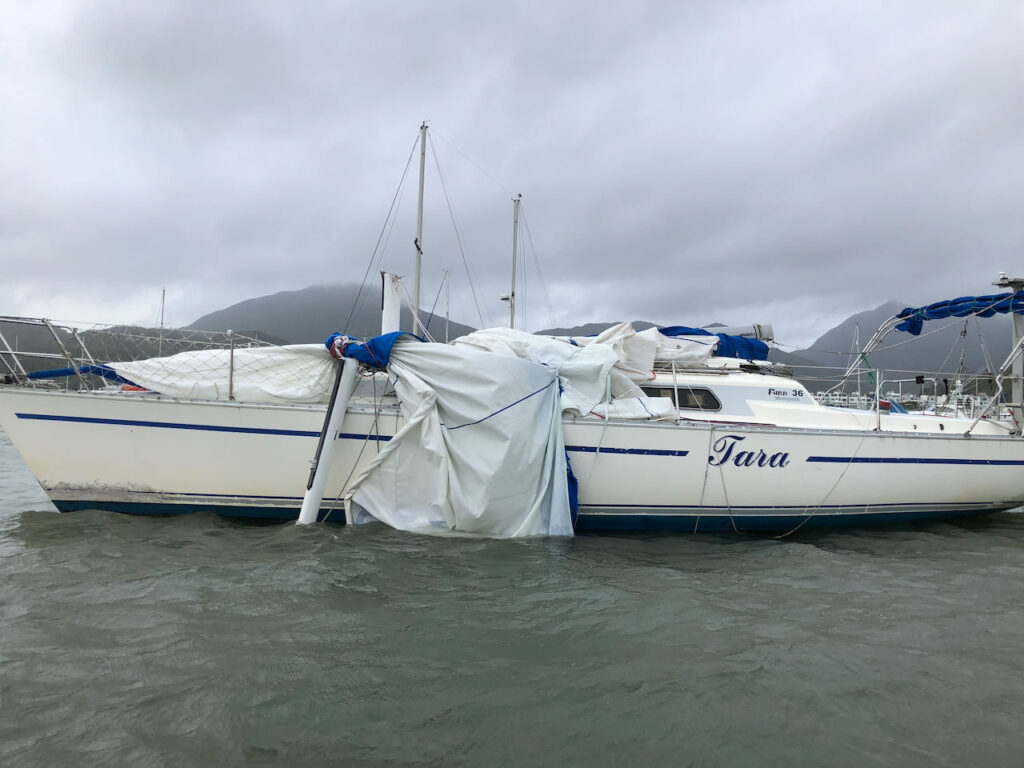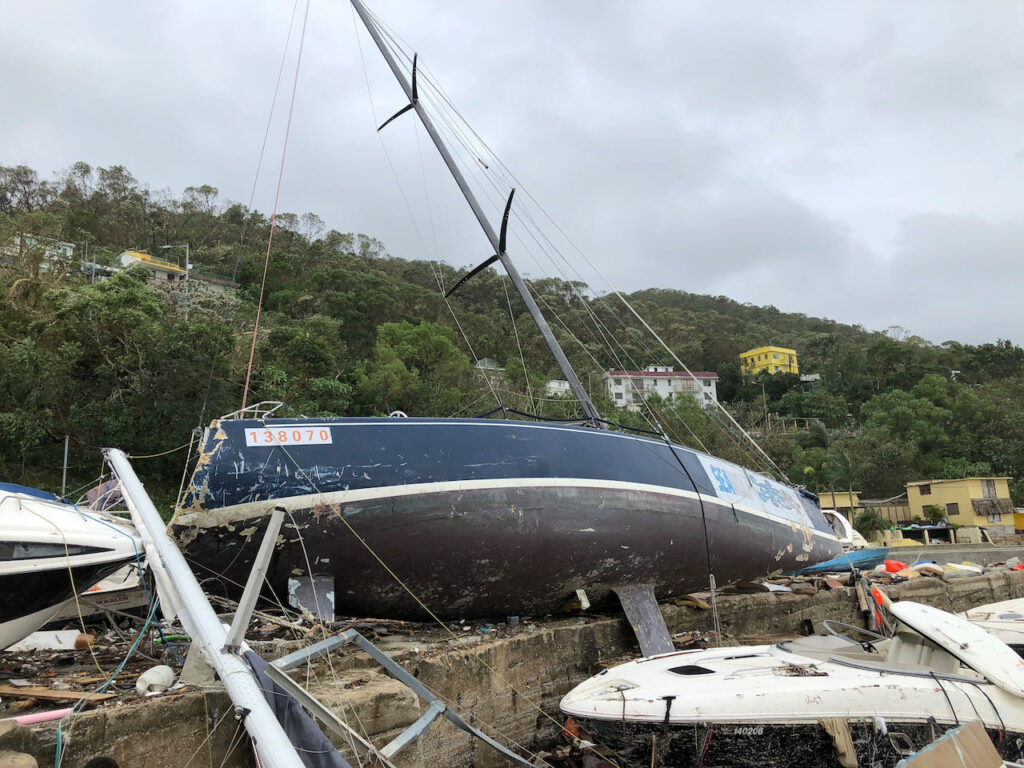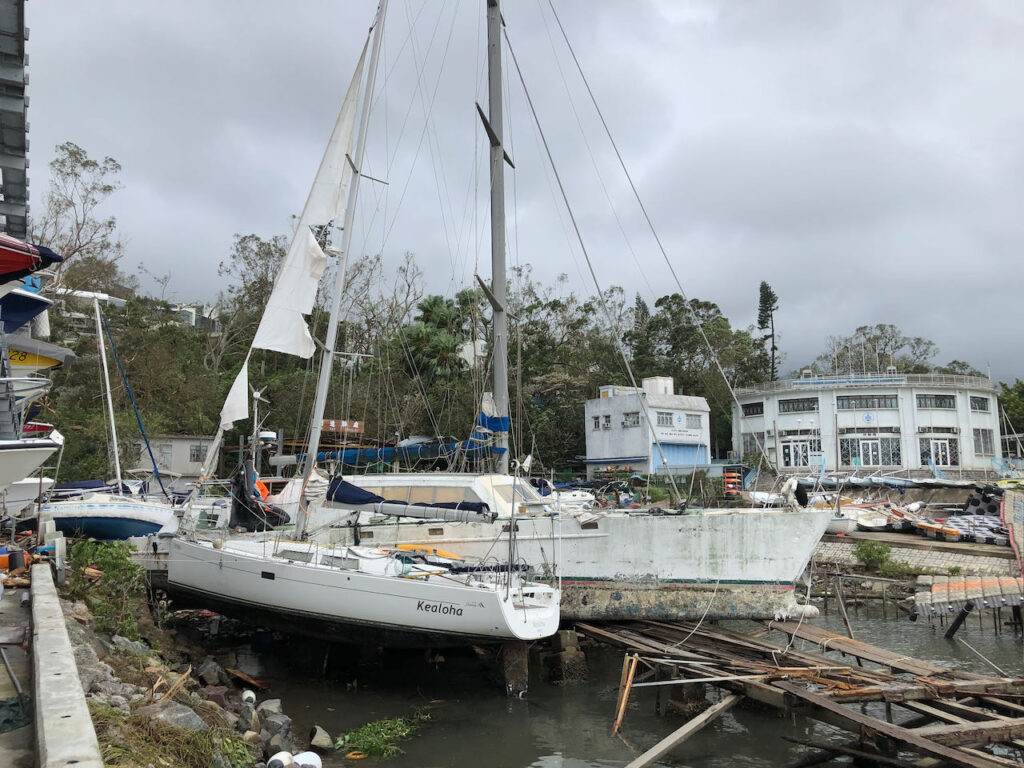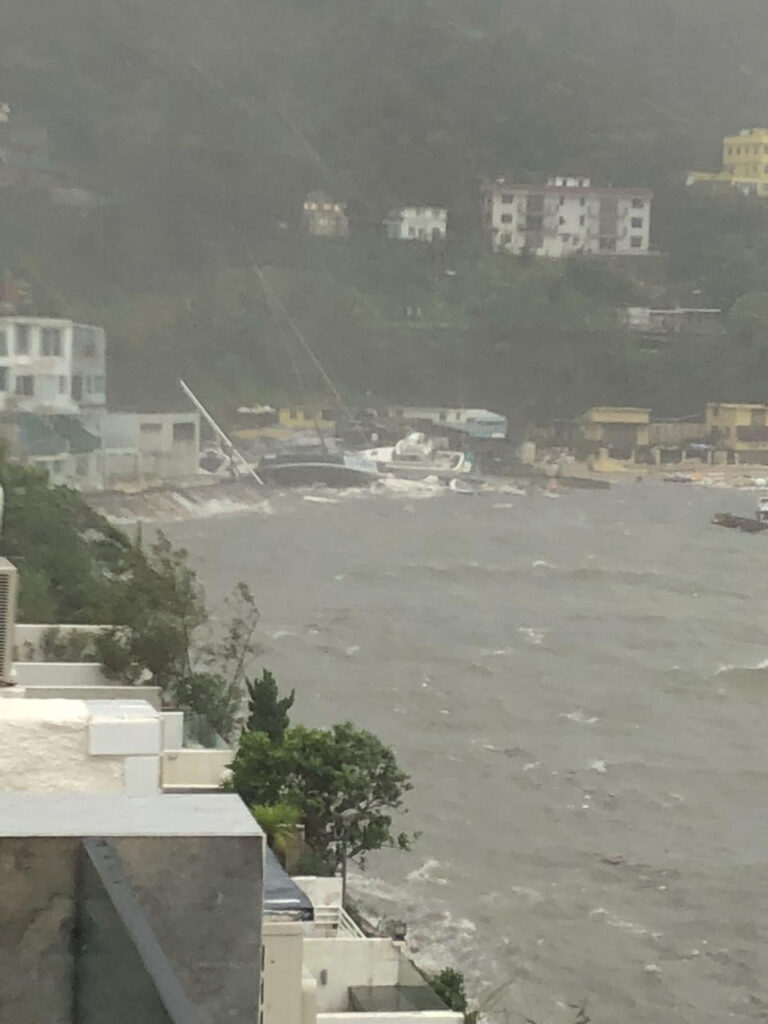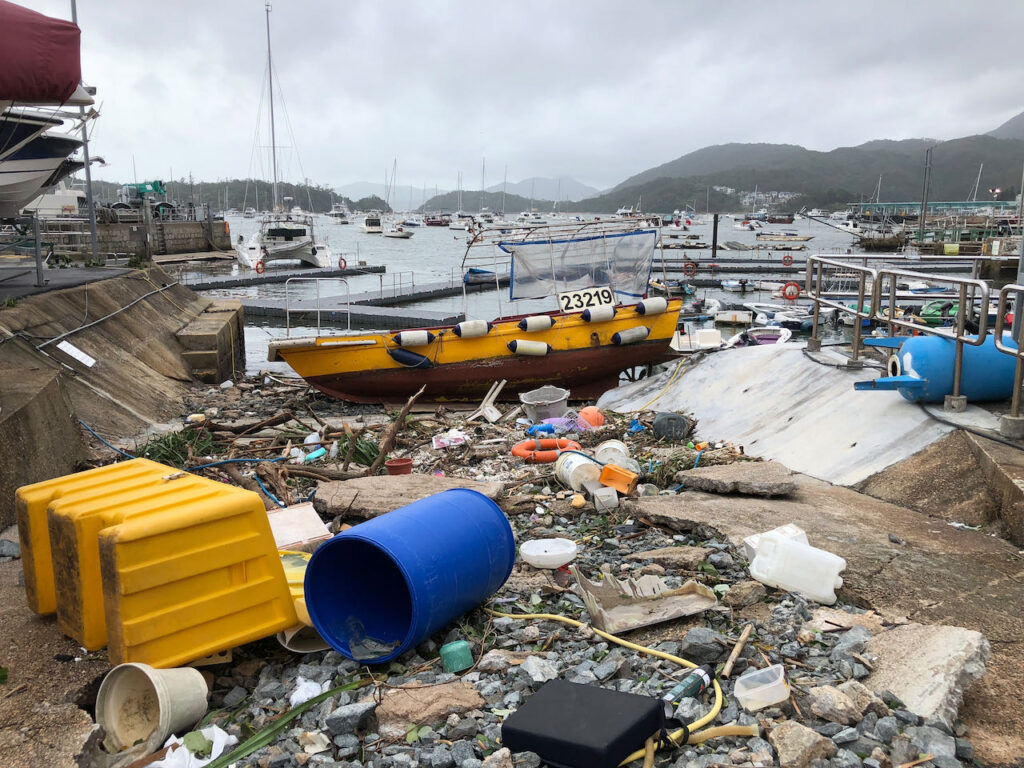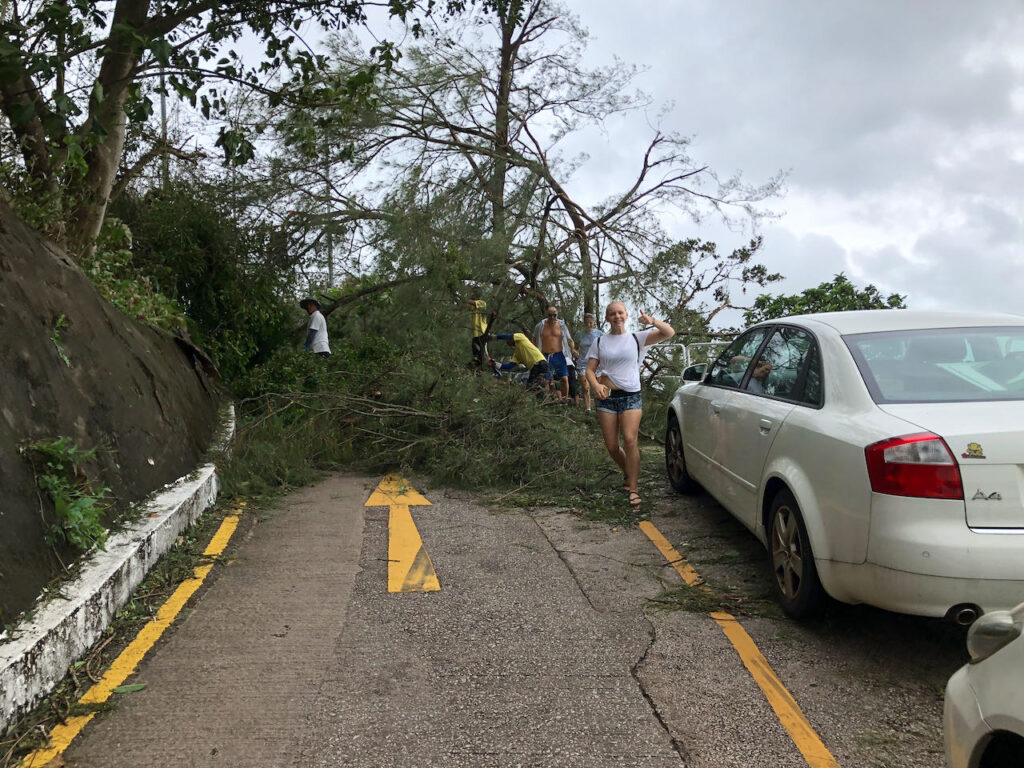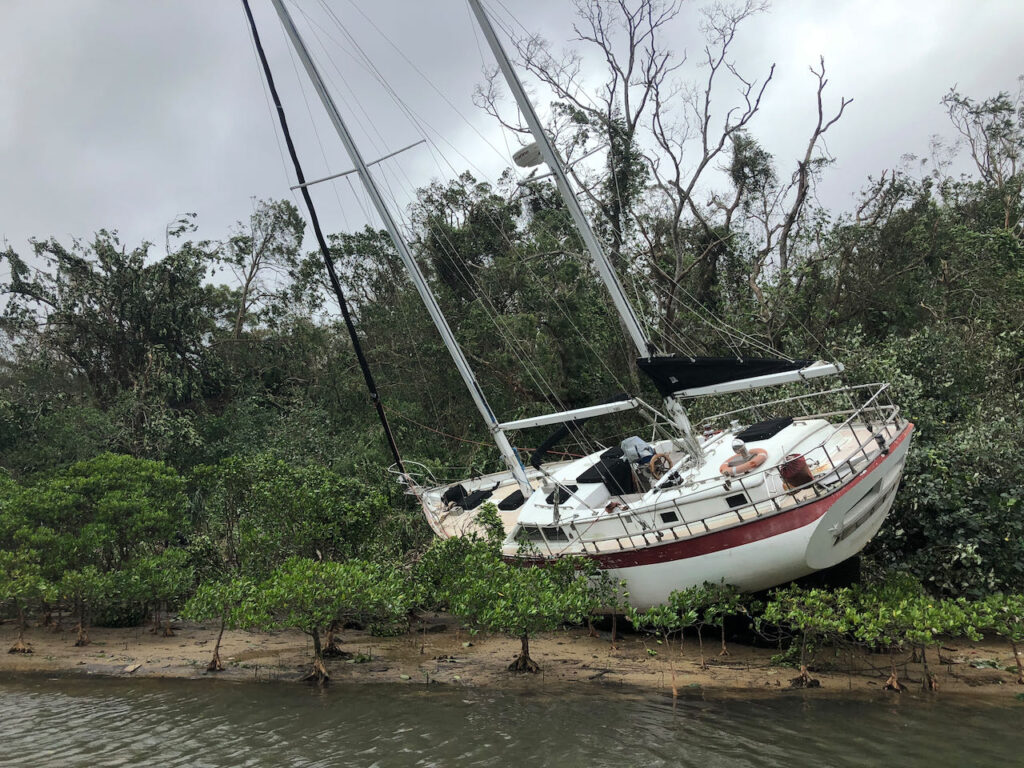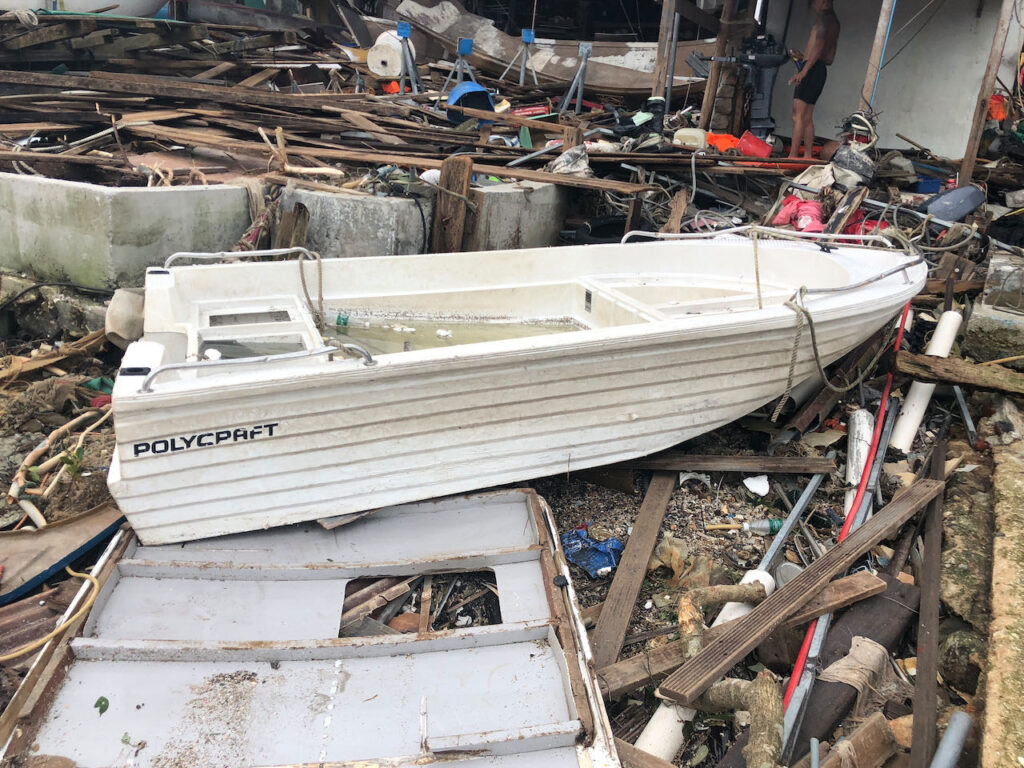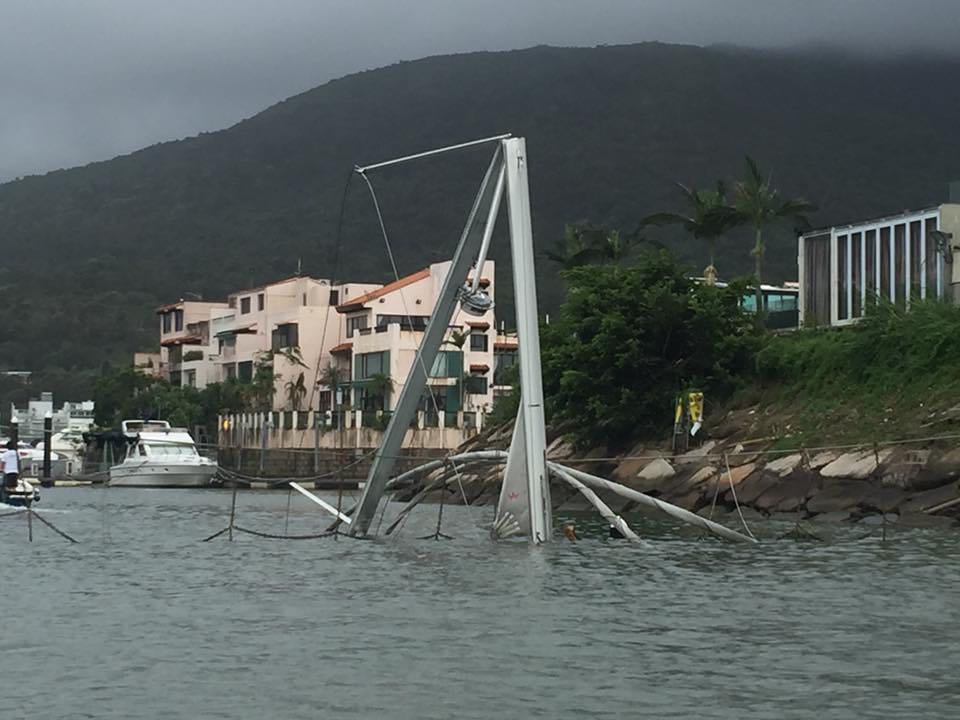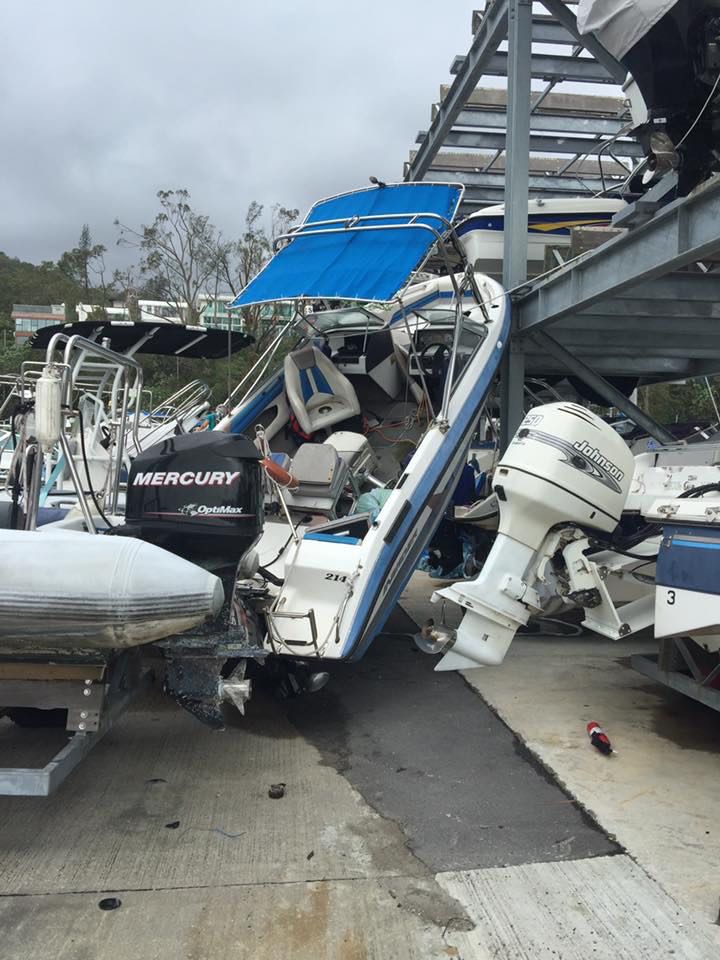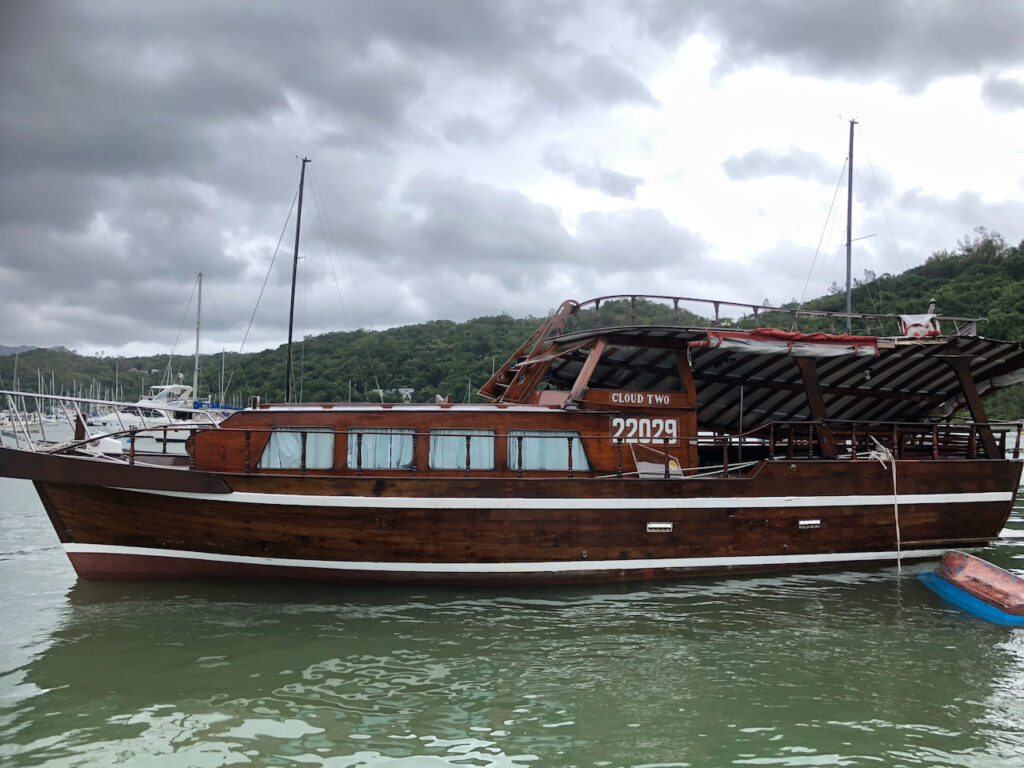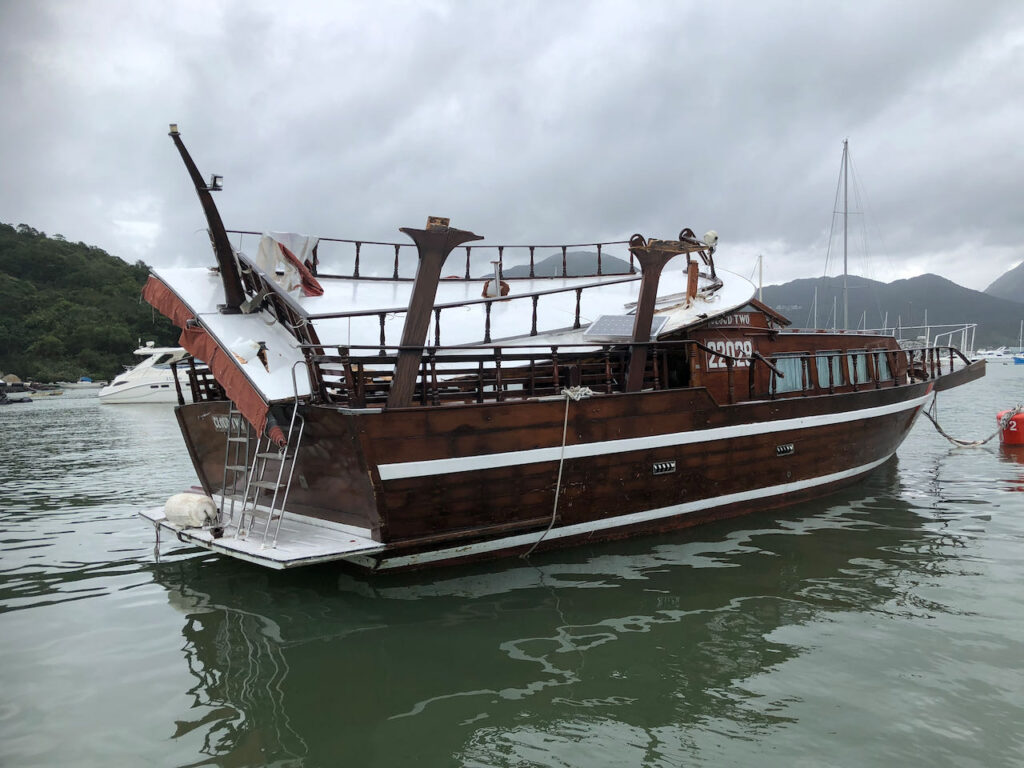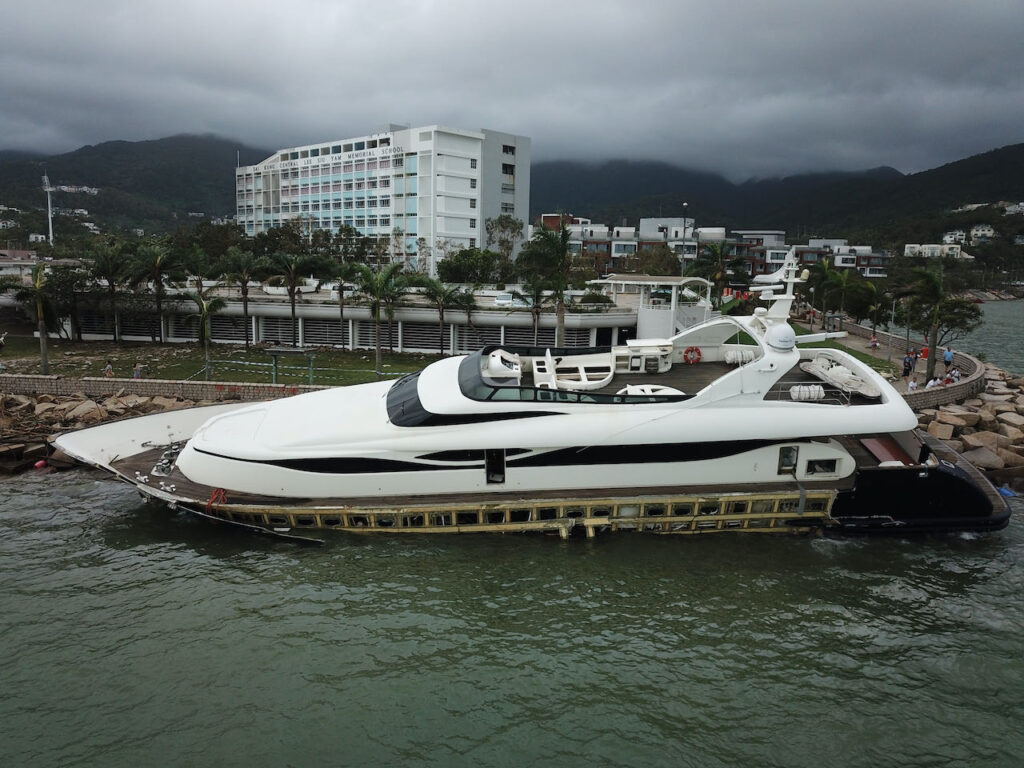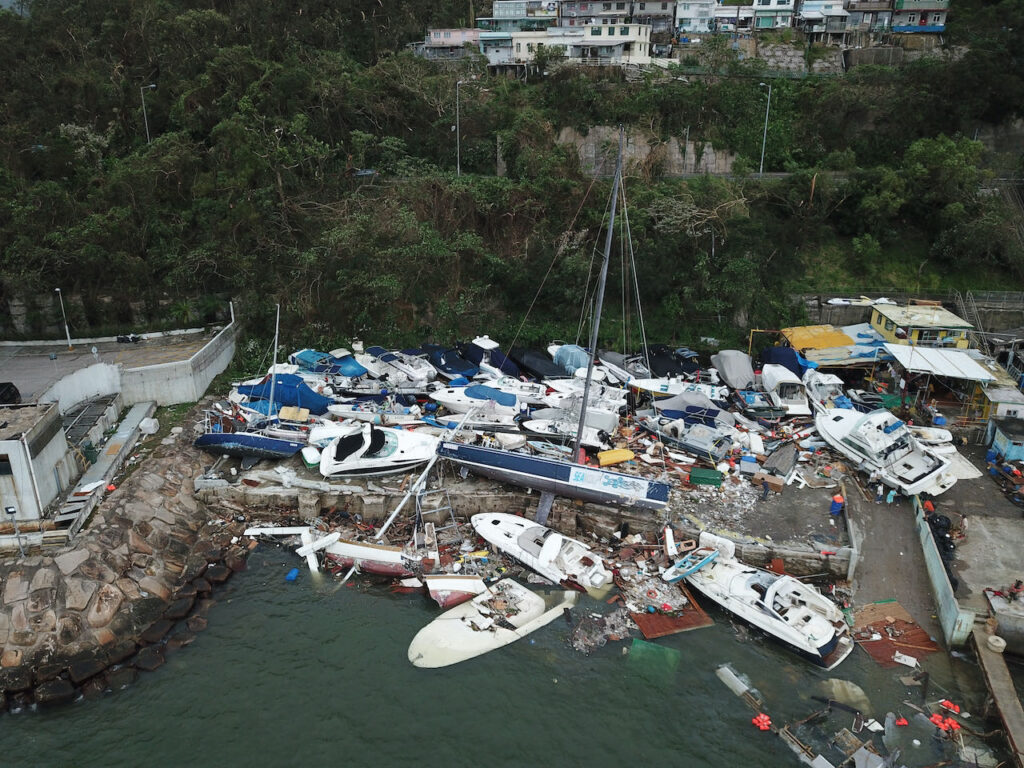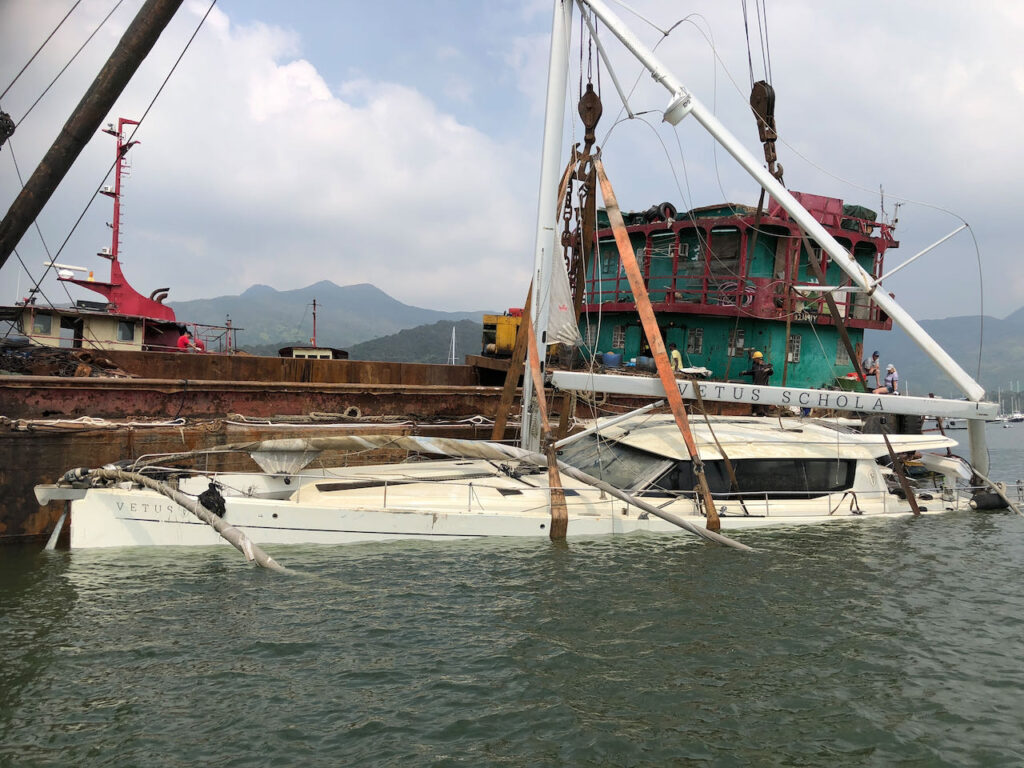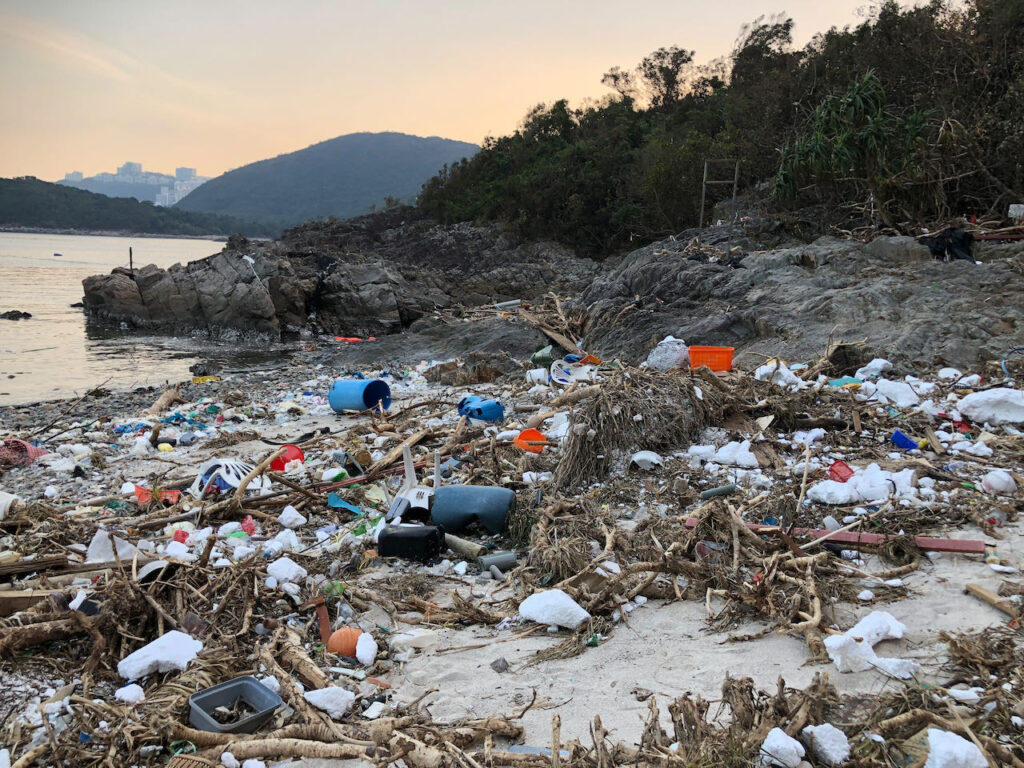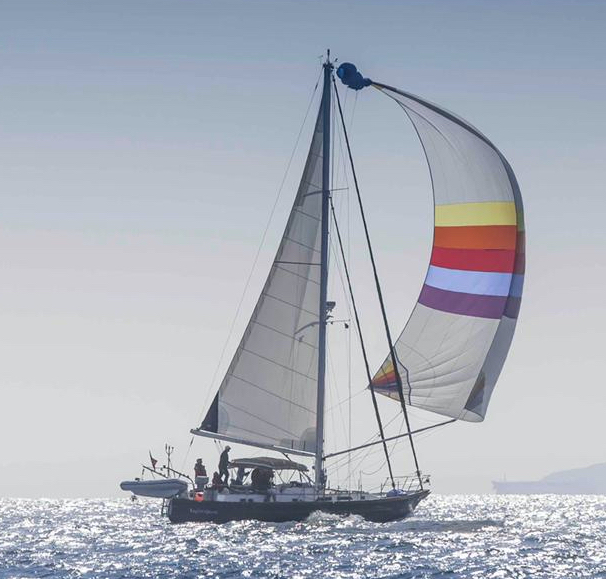TYPHOON MANGKUT – Hebe Haven gets slammed by T10 storm
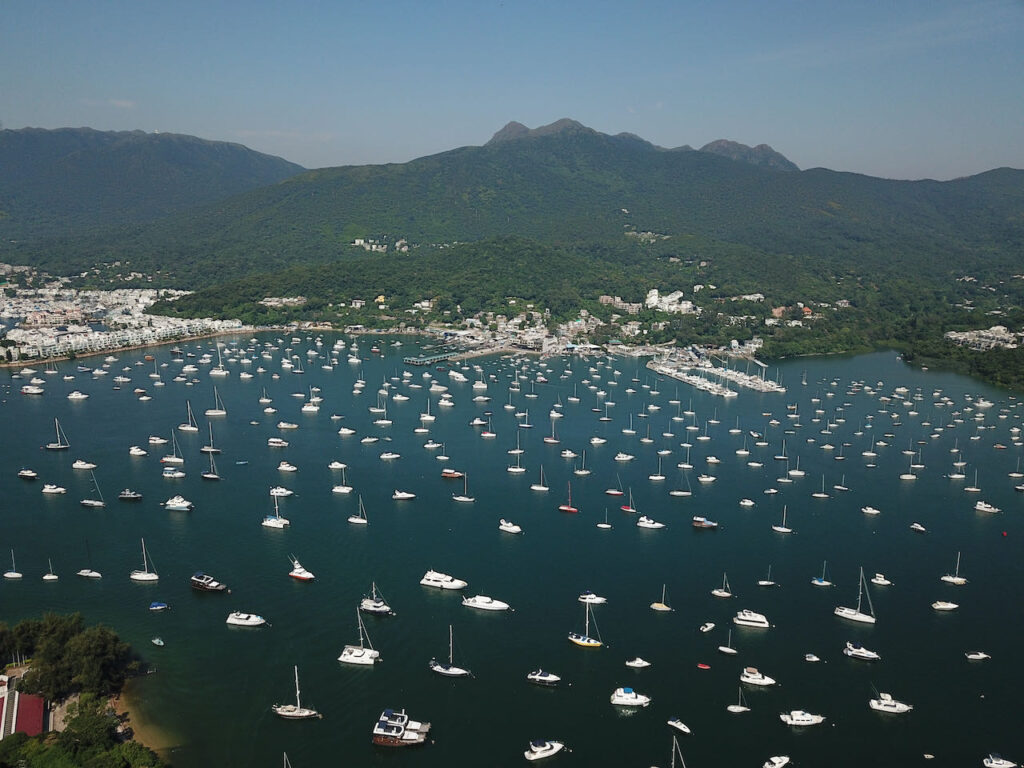
Super Typhoon T10 hits Hong Kong Saturday September 15th 2018
On Saturday, September 15th, the night before Typhoon Mangkhut hit Hong Kong, a few members of Hebe Haven Yacht Club gathered in the bar for an after-work drink. This time, we were all exhausted from the last few days preparing our boats for the approach of this Super Typhoon.

Typhoon Mangkhut started as a tropical depression out in the middle of the Pacific Ocean near the Marshall Islands. By the time it reached Rota and Guam, it had grown into a Super Typhoon, causing extensive flooding and damage on the islands—luckily, no one was killed. The storm then headed due west, building in strength and size, hitting Luzon five days later with 180 knot winds. Luzon suffered extensive damage, with over 90 deaths reported.
Once Mangkhut reached Luzon, we knew Hong Kong was in trouble. We had all been watching this storm on Windy.com for the last 10 days, hoping the track would change and Mangkhut would swing north up to Taiwan or south to Hainan, as had the previous 22 storms of the 2018 typhoon season. The only problem was that Mangkhut filled the entire South China Sea. This storm was 550 miles across and had an eye almost 70 kilometers in diameter—the biggest, strongest storm anywhere on the planet in 2018.
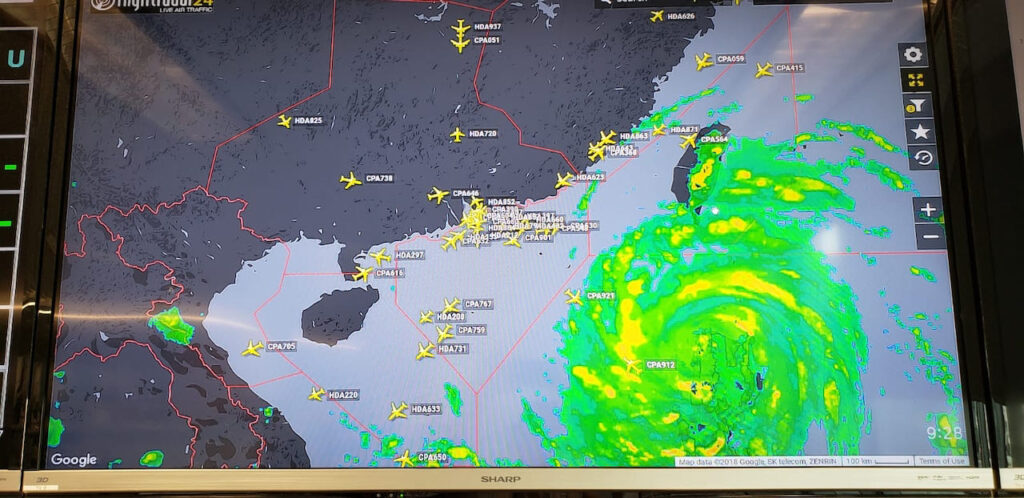
It had been blowing a steady 20 knots from the north all day and was hot, hot as a snake’s bottom in a brush fire—a typical pre-typhoon day, but one that belied the ferocity of the next 24 hours. By midnight, the wind started to pick up, but we didn’t care; we were drinking nice wine with friends. We missed news of the T8 signal as we ordered a last round before bed.
About 3 a.m., the first big gusts hit. By 6 a.m., all hell was starting to break loose.
A slight hangover from the previous night’s red wine kept me in bed a little longer than normal. The boat was already rocking around worse than any typhoon I’d ever experienced. I didn’t want to get up; I knew this was going to be a crazy day, and I didn’t feel up for the challenge. It was only when the first 80 knot gust hit and the kettle fell on the floor that I thought it time to get up. Opening the hatch and sticking my head above was an instant wake-up.
Out in the bay, there was already a 2 to 3 foot chop with white horses blowing the tops off the waves. Grabbing my oilskins, I headed over to North Dock to see how things were going. No sooner had I walked 50 meters down the dock than Dan appeared. “Come on, Sean, Sea Vixen has broken a cleat on the dock,” he said—and so it began.
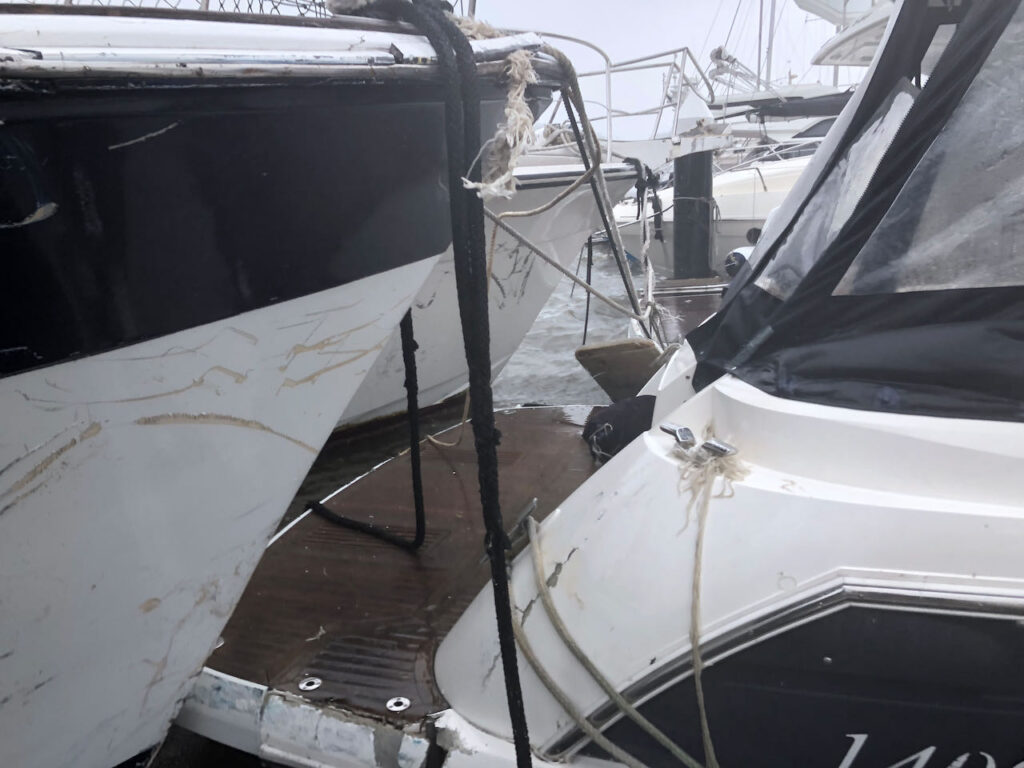
We scurried over to N32 to see Sea Vixen had indeed broken a cleat on the dock. Dan hurried to find some ropes as we tried to secure Sea Vixen to the pontoon. At this point, the wind had picked up and was now blowing north-northeast, 80 knots sustained, as it did for the next 10 hours, swinging from north to NNE, NE, E, ESE, SE! (Did I get that right? LOL.)
Little did we know that the Observatory had just raised the T10 signal, only the third such signal since 1999. Wind speeds at the Observatory in Victoria Harbour were registering gusts of 110 to 120 knots, or 225 kilometers per hour—devastating winds.
After helping Dan secure Sea Vixen, I headed back to S12, where my boat, SV-Malarky 1, was tied up nice and secure, extra lines running to all the cleats around and another line running under the pontoon. SV-Malarky 1 was secure and doing well.
How does the old adage go? “It’s not your boat that causes the damage in a storm.” My upwind neighbor was not doing so well. The big Hansa 545 in S13 spat the dummy and broke all its deck cleats, sending it crashing over onto Malarky.
I spent the next half hour trying to tie lines to the Hansa, but the damn thing had no place to tie onto, so I lashed a line around the mast and pulled it through the bow roller and onto the pontoon cleat. No sooner had I done that when a massive gust popped that cleat, and the Hansa resumed humping Malarky. The Hansa had a swim ladder over the side that was trying to gouge a hole in Malarky. A couple of swift kicks to the ladder dislodged it out of the way. I then tied on a few more fenders.
Then, as I jumped up on the Hansa, trying to stuff fenders in between the two boats, I got the fright of my life. A massive gust blew both boats over so hard I saw Malarky’s keel! Standing on the Hansa, I was almost thrown into the gap of the two boats crashing together, but I’d managed to grab one of the stays. It was at this point that I decided to “ABANDON SHIP.”
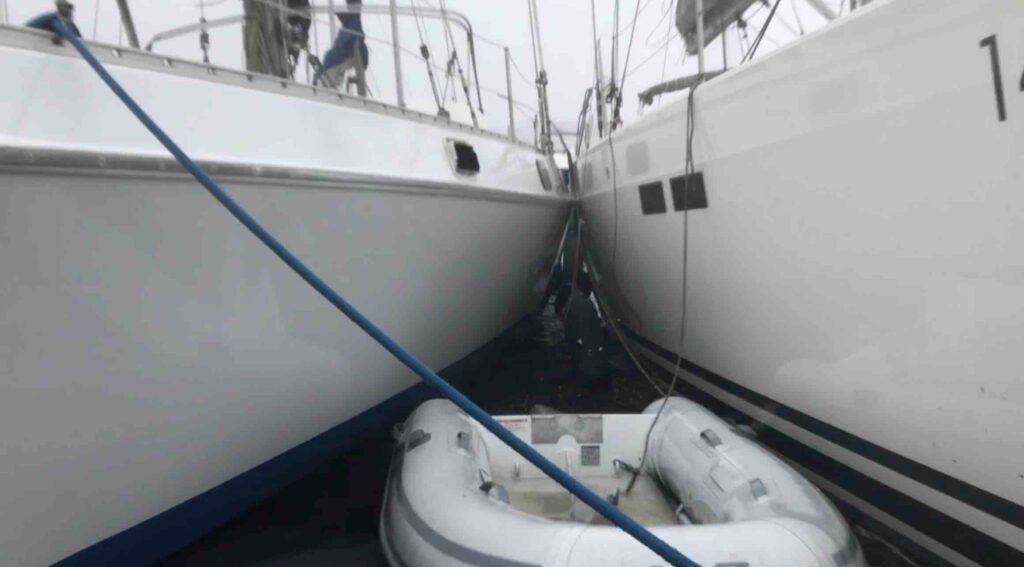
Dammit, there is nothing I can do at this point. Mother Nature was screaming her fury at us, and it was time to “RUN AWAY, RUN AWAY” (said in a Monty Python accent). Jumping across to Malarky, I went below to a very messy cabin. I had not prepared the boat down below for the storm, and the floor was now covered in broken coffee mugs, tins of food, and whatever else had been on the counter. The chart table had also emptied onto the salon floor—what a mess. Quickly, I grabbed my passport, birth certificate, and bitcoin, threw a few clothes into a dry bag, and kissed Malarky’s plaque. I took one last look around, wondering if this would be the last time I saw my boat.
With spray stinging my face, doubled over as I ran up the pontoon with Bonnie, the ship’s dog, I had to hold her collar as the wind was about to blow her off the pontoon. We made it to the safety of my car, which I’d left at the top of the ramp as an escape pod.
In S1, Onyva’s headsail blew out with the next big gust, and the noise of it flapping in the wind was cacophonous, like a machine gun—pa pa pa padt! Everything was going sideways now—wind, waves, and spray all going horizontal, with the sound of jet engines screaming in my ears. This was starting to get scary.
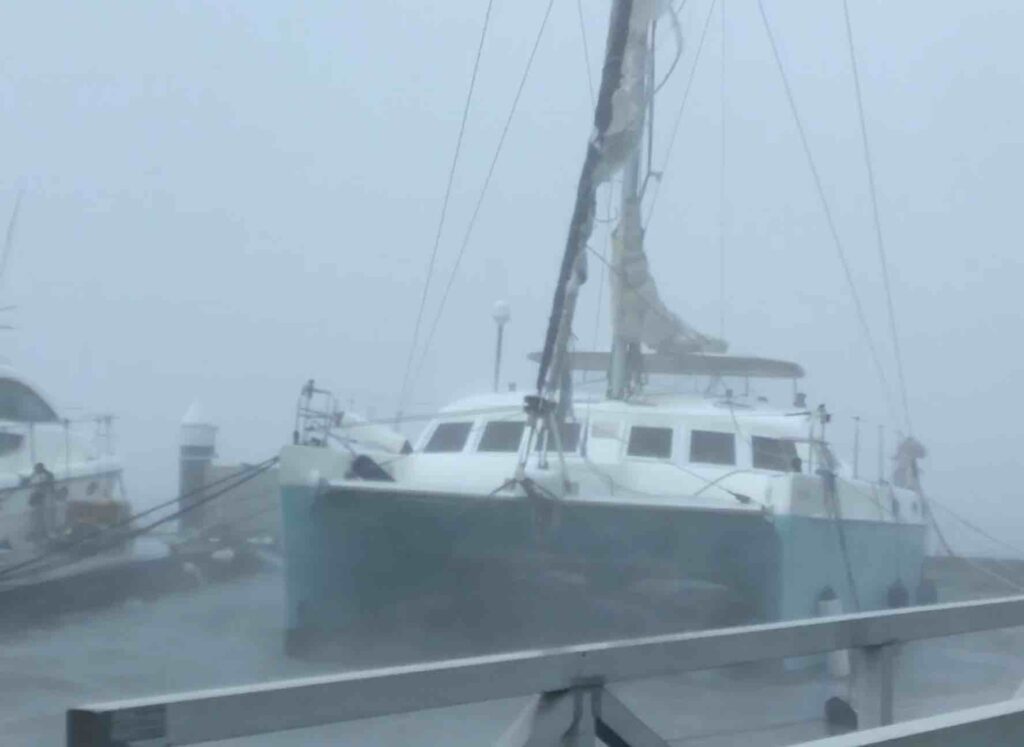
I looked out to the moorings; there was Bit’s n Pieces doing a crazy dance. Starboard rail buried, she’d tack over, sailing up on the mooring—now port, now starboard, now port. Each time she went over, I was amazed to see her right and ready to take on the next gust. Good girl—surely Toby was watching over from Heaven.
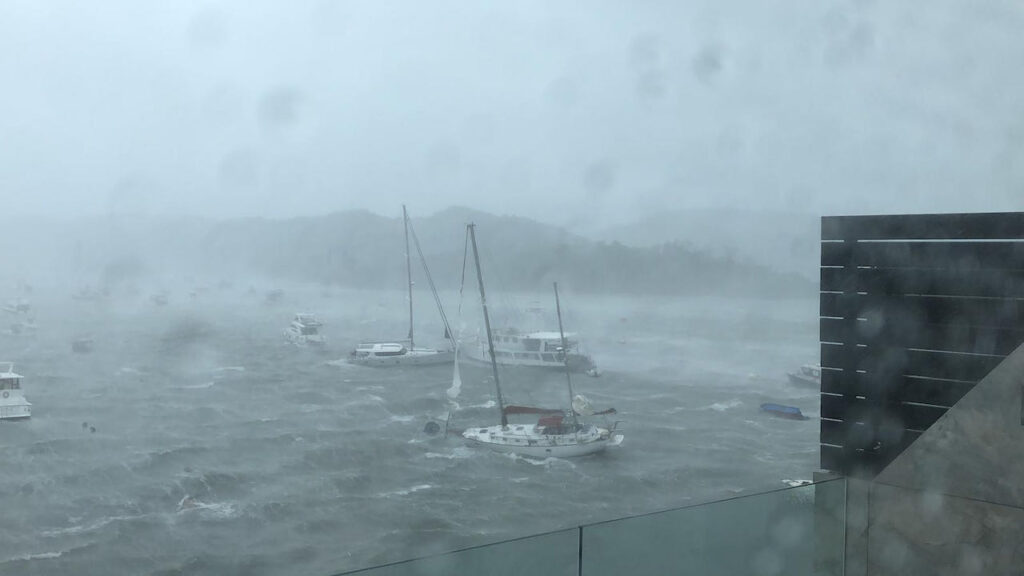
Stu appeared with crash helmet and goggles. I grabbed him and said, “Get in the car; we’ll drive up to the club and hide in the washrooms.” Just then, Dennis texted and said he was in the staffroom (the shipping container near the main gate). We headed up to safety to find Sammy and Charlie from Marine eating cup noodles. They welcomed us into the staff quarters and offered us hot cup noodles—the first thing I’d eaten.
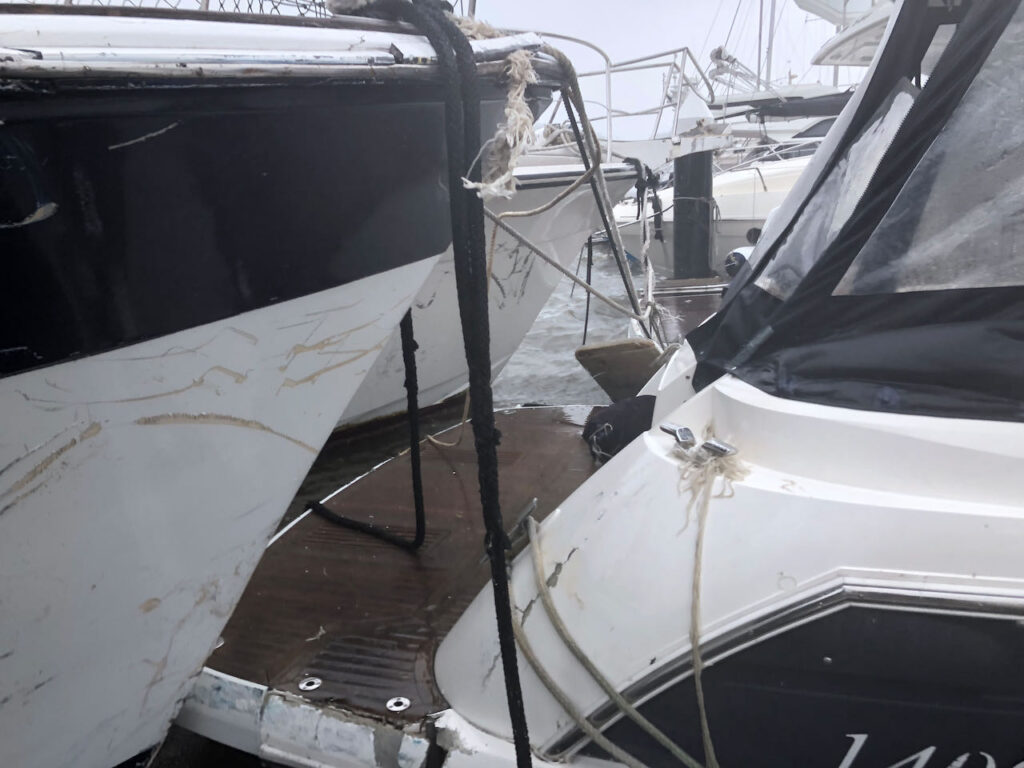
It was now about 11 a.m., and the wind was howling mad. Stu and I looked at each other. “Bloody Nora,” being Stu’s favorite epithet of derision. BLOODY NORA is right.
With dry fingers, I was now able to tune into our club Whatsapp group and see how other members and their boats were faring in these crazy conditions. I’d left my mate Ian, who had recently bought my 36 foot powerboat “Pula,” onboard, over by the Boy Scout camp. His text read, “I think this was a mistake. Would you please come get me when there is a lull?” I’d told him I’d have the Boston Whaler on standby if anything went bad; he ended up staying on board until the next day. The night before, I’d said, “Mate, you don’t have to stay on the boat; it will be very rough,” but as a new boat owner, he insisted on staying. He had not prepared very well, though. A bottle of Chivas and a few bags of chips were not going to see him through, so the night before, I’d dropped off a bag with some bread, bacon, eggs, jam, and a PFD (Personal Flotation Device). He laughed gingerly at the PFD.
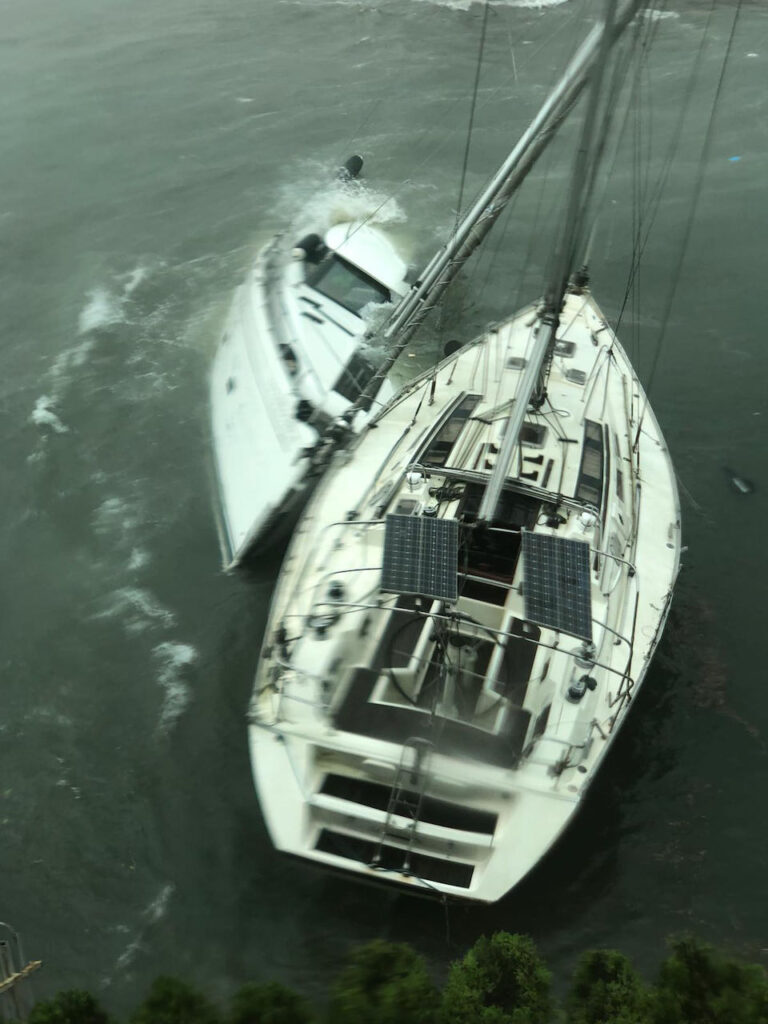
Sitting in the shipping container, we heard the first news that Vetus Scholar was loose; she must have broken her mooring lines. A photo on the group Whatsapp showed her heading toward Marina Cove. There was little anyone could do to save her at this point.
The wind was howling, 110 to 120 knots; there was a 1 meter swell coming down the channel next to the club. The UK sails box was pushed halfway up the parking lot and smashed against a member’s car. Water was flooding the garden bar and through the hallway in front of the general office. Several speedboats had blown off the top of the boat racks, damaging 2 of the Sailability 2.4RMS.
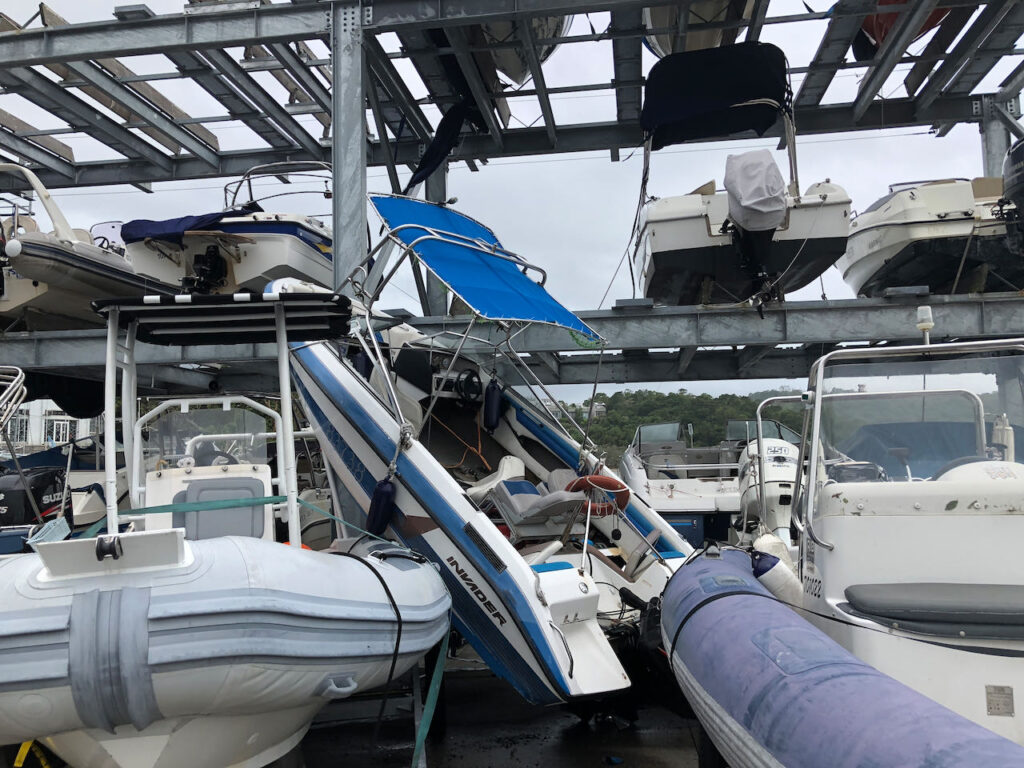
SV-Feral, Jim and Sue’s 70 foot catamaran, which had been tied up tightly in the estuary near Ta Ho Tun, came free and did a pogo dance along North Dock, starting with N40 at the top and scraping down all the way to N1. Nothing anyone could do to stop it; pretty well all the boats on North Dock suffered damage as a result of loose boats.
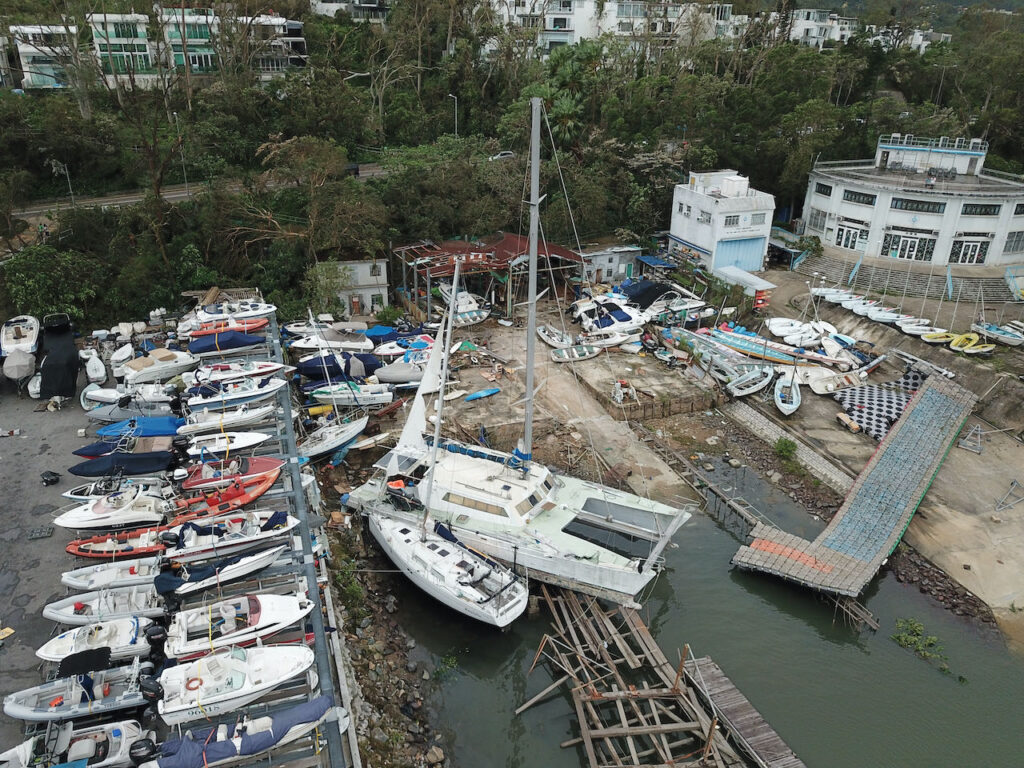
After about half an hour in the staffroom shipping container, we got word from Lisa, the club’s general manager, that Charlie would open up the clubhouse for us. Ah, a cold beer in the middle of the typhoon—great! Thanks, Lisa ☺ (of course we kept a tab).
We sat in the clubhouse, watching the waves crash over the shipyard. The whole shipyard was flooded. The ramp to the pontoons was higher than the shipyard and was starting to bang on the pontoon something awful with each big swell that passed. Eventually, the north ramp broke a hinge and tilted dangerously sideways. We now had knee-high waves rolling through the shipyard; kayaks, boat boxes, and rubbish floated everywhere.
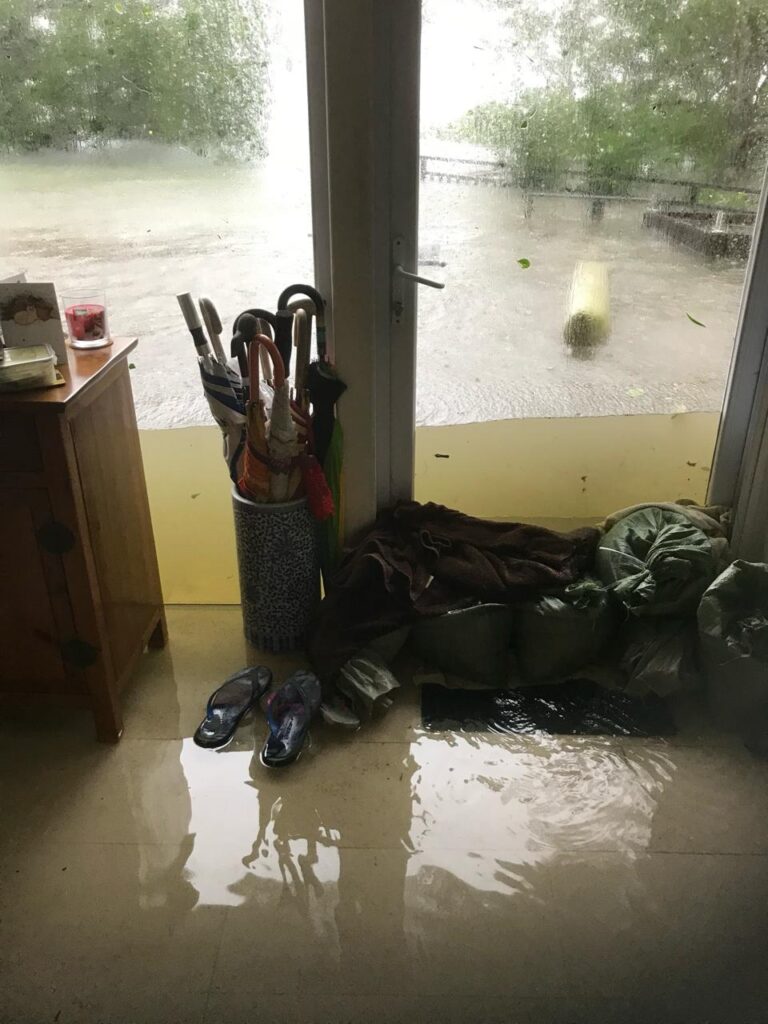
Putting on one of the sailing center crash helmets, I headed back down to see how Malarky was faring. The scene on South Dock was no better than North, and as the wind swung around to the east, both pontoons started to take a real beating. The big Hansa was riding up and down, screeching fiberglass on fiberglass and wood on metal as it tried to sink Malarky. I’d seen the big orange buoys the club uses for course marking and grabbed four of them on my way down the pontoon. I quickly stuffed these between the two crashing hulls, trying to stop the damage. One of the buoys popped like a balloon with the first crash of the hulls slamming together. Oh, this was scary.
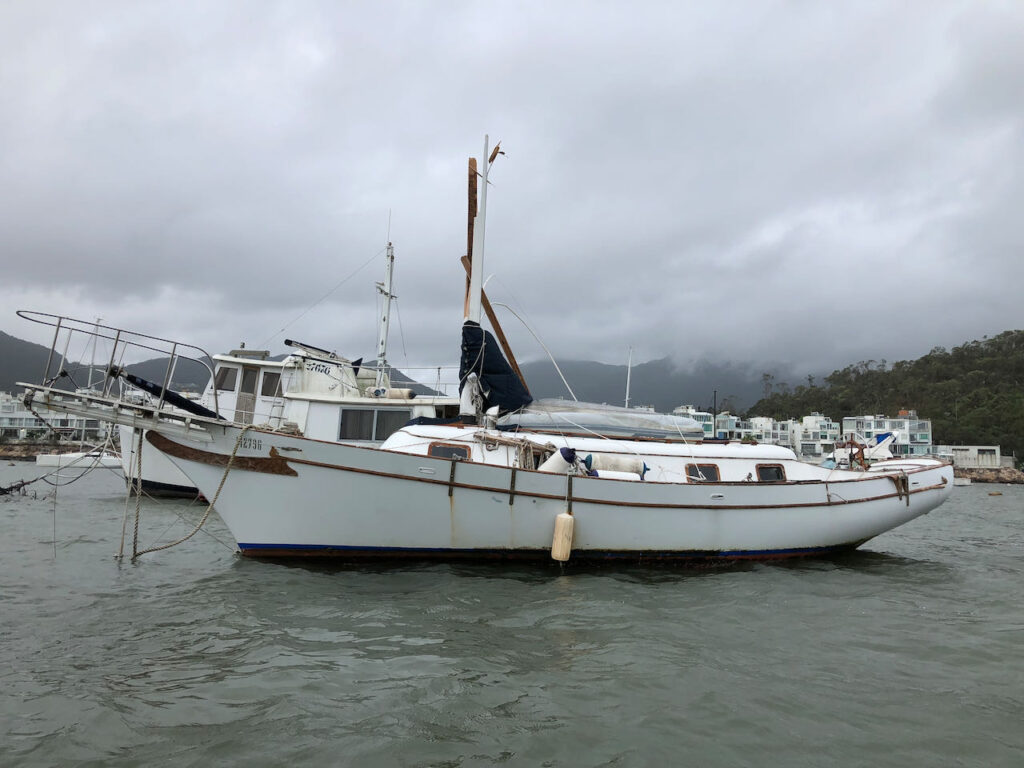
The pontoon between S12 and S11 started to bend and buckle with the weight of the two boats crashing on it. Then, with one massive gust, the joint that holds the pontoon snapped, and the end of the pontoon tilted over at about 45 degrees.
I ran to find Dan and Stu; we needed to fix this before the whole pontoon broke up, but they were busy on North Dock. SV-Daktari, the big Moody at the end of North Dock, had popped the cleats on the dock and was now humping MV-Flying Dragon, a brand-new Azimut 50.
At this point, the “boat boys” had joined the fray and were trying to get a line from the pontoon through the bow roller and onto one of Daktari’s big winches. We got a line on and winched her off Flying Dragon, just in time to go save Thomas and Pirko’s SV-Flucht8erl, and then onto Gauley’s SV-Magnum Mare. Then I remembered SV-Malarky was in trouble.
I grabbed a couple of the boat boys and headed back to South Dock. Arriving at S12, I saw the rebar in the pontoon was now sawing a hole under the waterline in the big DeFeeva 56 on the other side of the pontoon. I watched as it sawed back and forth, clouds of fiberglass sloughing off into the water with each swell that rolled through. Quickly, I cut the lines holding the dock box onto the pontoon and kicked it into the water. That did the trick; the pontoon righted just enough that now, instead of the rebar grinding Nigel’s boat below the waterline, it was grinding above the waterline. I grabbed another rope, tied it to the extruding rebar and around one of Malarky’s winches. Grinding hard on the winch, I pulled the pontoon away; now only the wood side of the pontoon was rubbing. That will have to do for now.

Time for another beer and rest. I headed up toward the club, but back at S1, Denis, Stu, and Dan were trying to secure a big powerboat that had blown in from the moorings and was now crashing against Onyva’s bow. The bimini cage on the stern was threatening to take out Onyva’s bow roller and front stay; had that happened, Onyva would lose her rig, and the club would lose a J80 as the rig crashed on it.

I jumped on the powerboat, rooted through its stern locker, finding some semi-serviceable ropes. (Why do people with big boats carry such small-gauge lines?) With much effort and pulling of ropes and bending of backs, we managed to get this powerboat off Onyva’s bow and secured to the guest berth.
Tired and hungry, the “typhoon amigos”—Dennis, Dan, Stu, and myself—headed up to the clubhouse for a break. Stu found his way into the kitchen, emerging 15 minutes later with microwaved bacon sandwiches—bloody nora gourmet!
Sitting eating my sandwich, I could see Malarky’s mast through the haze of wind, rain, and spray. It’s about the right height; okay, the boat is still floating. Oh, but what about that mast in front of Onyva? It should not be there. Another boat had drifted in from the moorings and was now also trying to sink Dennis’ fine turquoise catamaran. Donning our rain gear again, we headed back down to pull this boat off Onyva’s bow and secure it behind the powerboat.
The rest of the day was spent in similar fashion; several other members had come down now and were helping secure things around the club. Just before dark, the winds started to abate slightly—instead of sustained 80 plus, it was now 60 plus with gusts to 80. Back in the clubhouse, we had our first full glimpse of the mooring field.
My first thought was, “Where did all the boats go?” We’d lost about 30% of the boats in the mooring field—gone, sunk, or capsized.
On the Whatsapp group, friends started asking about their boats. Can you see Ate? Yes! Can you see Wind Ryder? Yes! Can you see Lai See? Yes! Can you see EQ? No! Eagles Quest, owned by my best friend! Dammit, EQ, where are you? I could not see EQ. Looking out over a darkening Pak Sha Wan, my heart jumped into my throat at the thought of losing EQ to this storm.
I grabbed my rain jacket and ran down to Malarky to find my binoculars. Bracing against the wind, my elbows planted on the shipyard railing, trying to steady the binoculars, I caught a brief glimpse of EQ’s davits and dinghy in the fading light. What a relief—EQ was on her mooring!
I then turned my attention to spotting other friends’ boats to report back to them. And then I saw SV-Jade! SV-Jade, why are you sideways to the wind, and why are you getting bigger? Oh, fuck—Jade is loose. I sprinted toward the clubhouse to get help. “Dan, Dan, Jade is loose and heading this way!” I jumped in my Boston Whaler, which had ridden out the storm sheltered under the big crane, started the engine, and gunned it toward Jade. She was just bouncing off Triton and was about to head toward SUN Marine next door, surely to be wrecked on the jet ski dock.
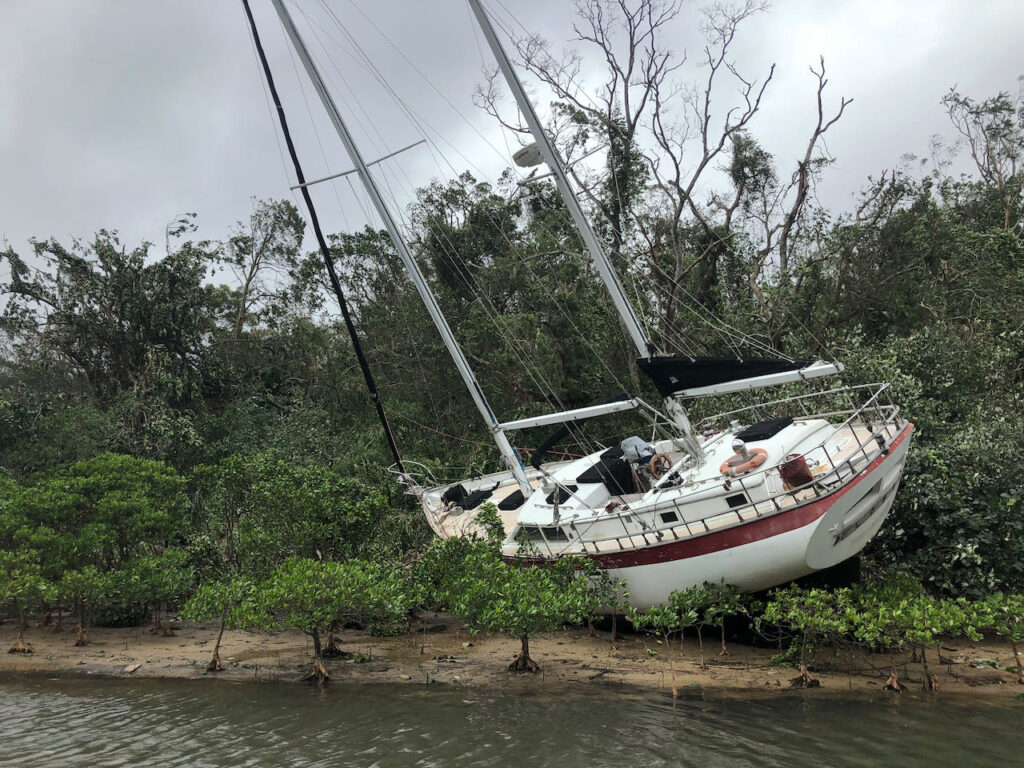
With the Boston riding up and down on the swell, somehow I managed to get a line around Jade’s bow cleat and gunned the motor in reverse. At first, it had no effect; Jade kept moving toward her doom. Then, slowly, she started to swing like a pendulum across to the red zone, where Dan managed to grab a line around the last cleat on the pontoon.
“Ha HAAAAAA,” I yelled at Jade in triumph, “You are not getting away!”—the adrenaline of the day pumping in my veins. We grabbed a couple of the crane slings, daisy-chained them together, and secured Jade to the crane base.
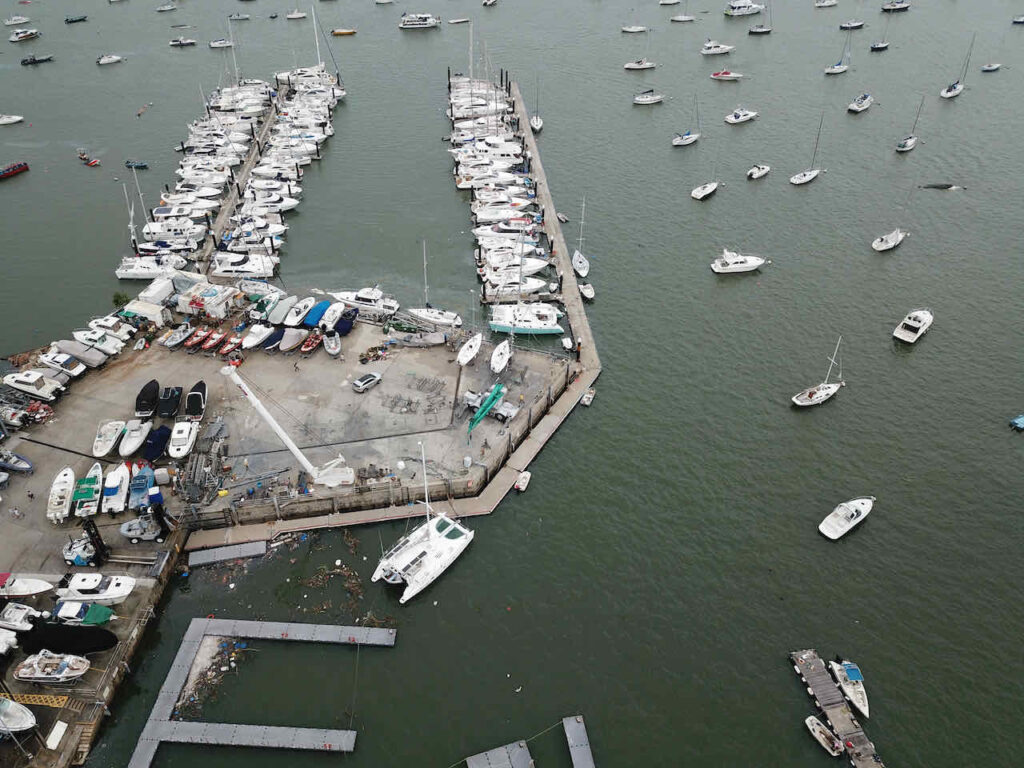
As darkness descended on Hebe Haven, the winds fell off—60, then 50, then 40 knots. Time for a beer and call it a day. Nothing more we could do now till morning.
I texted Ian out on the powerboat. “How’s things, mate?” “I ran out of beer,” was his reply. “You okay till morning?” “Yeah, fine,” he answered. “Brave man,” I said. You’ve just weathered the worst storm in Hong Kong’s recent memory—a Cat 4 hurricane—on a 36 foot powerboat with very high freeboard. I can only imagine what he went through. Good fella.
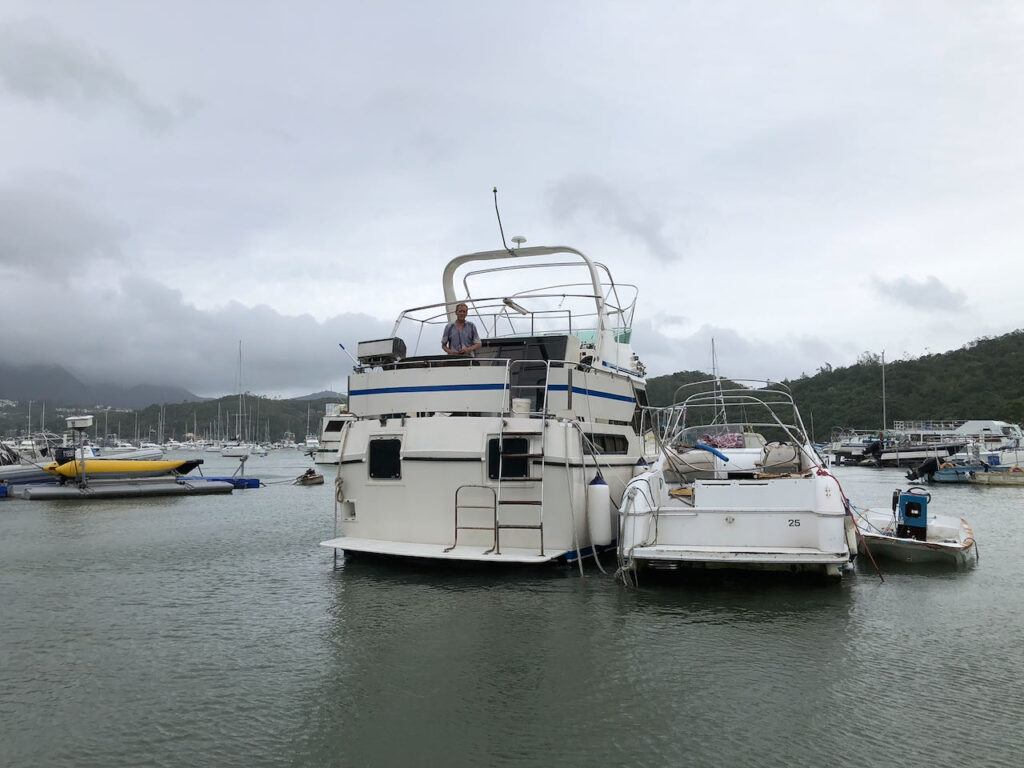
A few more beers in the club, then back to Malarky—I was asleep before my head hit the pillow.
Waking up the next day, I realized I was lucky to be alive. I’d been a big idiot, pretending to be a hero, saving boats, running around in the storm like Superman. Looking at the destruction around me, I realized I’d been stupid the day before. This was just stuff, and life is worth a lot more than that. Next time there’s a typhoon, I’m taking Malarky to a proper typhoon shelter, stripping every inch of canvas, saying a prayer, and going to my office to ride out the storm. Typhoons are not fun!
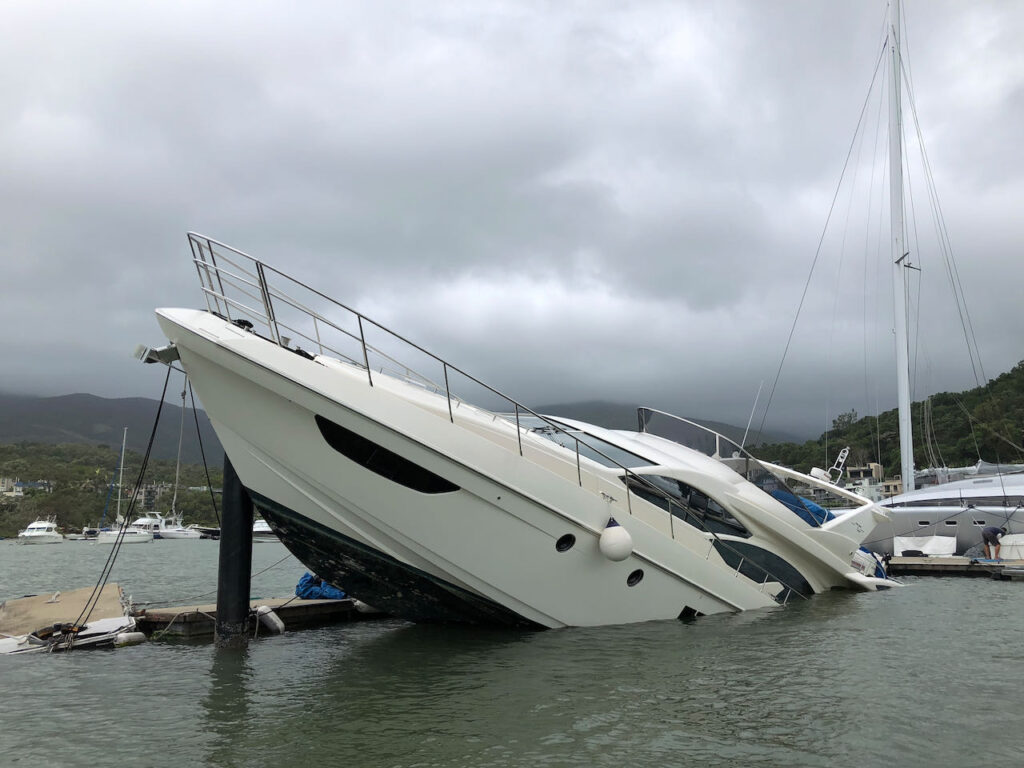
Notes:
- Never leave your headsail up in a storm, I counted 28 boats with blown out headsails 6 of them that lost their mast as a result.
- The pilings of the pontoons need extending at least 1-2m. We were less than 30cm from having the pontoons float off the top of the pilings, had this happened we lose the whole marina and every boat in it. (We did not have SPRING TIDES, luckily. Had we then add another 2m to the surge)
- All cleats on the pontoons need to be replaced with much stronger ones. Mostly the bolts snapped, but quite a few of the cleats also broke.
- Never buy a boat with those stupid pop up cleats.
- The bigger heavier the rope you use, the better. I will be replacing all my mooring lines with heavy 3’’ gauge lines.
- The Pontoons all need to be roped together for future storms. A system of anchor points needs to be installed to be able to criss cross ropes from North dock to south dock and back and forth.
- A barrier need to be set up at the top of the marina to prevent boats drifting in between the pontoons.
- All moorings need to be replaced with MUCH HEAVIER BLOCKS CHAIN AND SHACLKES. We lost so many boats to broken ground tackle.
- We got off lucky!
